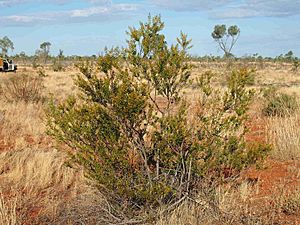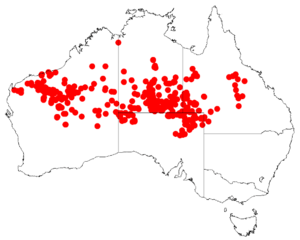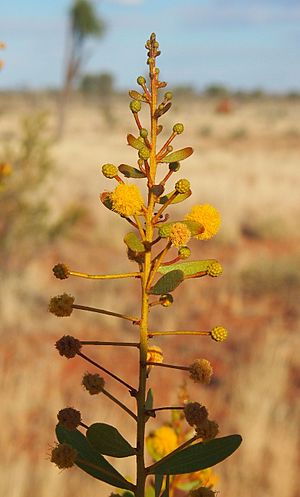Sandhill wattle facts for kids
Quick facts for kids Sandhill wattle |
|
|---|---|
 |
|
| Scientific classification | |
| Genus: |
Acacia
|
| Species: |
dictyophleba
|
 |
|
| Where this plant grows (data from AVH) | |
The Sandhill Wattle (also called Acacia dictyophleba) is a special type of shrub. It's known by a few names like waxy wattle and feather veined wattle. This plant is part of the Acacia family. Different Aboriginal groups have their own names for it. The Nyangumarta people call it Langkur or Lungkun, and the Thalanyji people call it Jabandi.
Contents
What the Sandhill Wattle Looks Like
This shrub often grows in a rounded or spread-out shape. It can be anywhere from about 2 feet to 13 feet tall. The plant has a sticky, resin-like feel. It usually blooms with bright yellow flowers from March to September.
Its stems are often straight and don't have many branches. They are covered in smooth, light grey bark. The leaves, called phyllodes, are shiny and dark green when they are young. As they get older, they turn a pretty blue-grey color.
These leaves are shaped like a spoon, wider at the top and narrower at the bottom. They are usually about 2 to 3.3 inches long and 0.3 to 1.1 inches wide. Often, a white, waxy coating covers the leaves. This coating comes from dry resin.
The flowers grow in small, round or oval clusters. Each cluster is about 0.3 to 0.5 inches across. They are packed with 40 to 60 golden flowers. After the flowers bloom, flat, light brown seed pods appear. These pods are like paper and are 1.5 to 3.5 inches long and 0.4 to 0.6 inches wide. Inside, you'll find shiny, brown seeds shaped like small oval beads.
How the Sandhill Wattle Got Its Name
The Sandhill Wattle was first officially described by a botanist named Ferdinand von Mueller in 1863. He included it in his work called Fragmenta Phytographiae Australiae.
The plant's scientific name, dictyophleba, comes from two Greek words. Diktyon means "net," and phlebo- means "vein." This name describes how the small veins in the plant's leaves look like a rough net.
This plant is related to other wattle species. Some of its close relatives include the Scented Wax Wattle and Acacia jensenii.
Where the Sandhill Wattle Grows
The Sandhill Wattle is found in several parts of Australia. It grows naturally in the Goldfields-Esperance, Pilbara, and Mid West areas of Western Australia. You can also find it in the desert regions of inland Australia. This includes the southern part of the Northern Territory, northeastern South Australia, and southwestern Queensland. It's very common in the Simpson Desert.
This plant likes to grow in red sandy soils. It can be found on sand dunes and stony plains. It also grows in other soil types like stony loam, sandy loam, or clay-loam.
The Sandhill Wattle often grows in open shrublands or woodlands. It shares these areas with other Acacia and Eucalyptus trees. It can also be found in areas with spinifex grass. After a bushfire, you might see small, thick groups of these wattles growing back.
Uses of the Sandhill Wattle
The Sandhill Wattle is a great plant for gardens because of its beautiful flowers and attractive leaves. It grows quickly and is very tough. It can handle both frost and dry weather, making it a good choice for many places. It also helps the soil by adding nitrogen, which is like a natural fertilizer.
The seeds of the Sandhill Wattle can be eaten. The leaves, called phyllodes, can be chewed. People have also used the leaves to make a tea. This tea was traditionally used to help with colds and headaches.
The bark of the plant contains substances called tannins. These tannins can be used to help with stomach problems like diarrhoea. The wood from the Sandhill Wattle can be used as fuel for fires. It can also be used to make strong fence posts.


